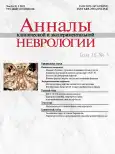Редкое сочетание рассеянного склероза и болезни Паркинсона: клинический случай
- Авторы: Руина Е.А.1, Александрова Е.А.2, Паршина Е.В.2, Родыгин Д.Н.2, Юлин В.С.2
-
Учреждения:
- ФГБОУ ВО «Приволжский исследовательский медицинский университет»
- ГБУЗ НО «Нижегородская областная клиническая больница имени Н.А. Семашко»
- Выпуск: Том 16, № 3 (2022)
- Страницы: 83-91
- Раздел: Клинический разбор
- URL: https://journals.rcsi.science/2075-5473/article/view/124069
- DOI: https://doi.org/10.54101/ACEN.2022.3.10
- ID: 124069
Цитировать
Полный текст
Аннотация
При анализе отечественной и зарубежной медицинской литературы, баз данных Web of Science, PubMed, Scopus обнаружены описания 8 случаев комбинации болезни Паркинсона и рассеянного склероза. Болезнь Паркинсона — хроническое прогрессирующее заболевание головного мозга, обусловленное дегенерацией дофаминергических нейронов чёрной субстанции. Рассеянный склероз — хроническое, демиелинизирующее заболевание, в основе которого лежит комплекс аутоиммунно-воспалительных и нейродегенеративных процессов, вызывающих множественное очаговое и диффузное поражение центральной нервной системы, ведущее к инвалидизации больных и значительному снижению качества жизни. Сочетание двух параллельно текущих нейродегенеративных заболеваний ЦНС редко встречается в клинической практике.
Приведён наблюдавшийся авторами клинический случай, интересный с точки зрения подхода к диагностической и лечебной тактике у данной группы пациентов.
Полный текст
Открыть статью на сайте журналаОб авторах
Екатерина Андреевна Руина
ФГБОУ ВО «Приволжский исследовательский медицинский университет»
Email: vadik.yulin@yandex.ru
ORCID iD: 0000-0003-4595-2614
к.м.н., доцент кафедры неврологии, психиатрии и наркологии
Россия, Нижний НовгородЕкатерина Александровна Александрова
ГБУЗ НО «Нижегородская областная клиническая больница имени Н.А. Семашко»
Email: vadik.yulin@yandex.ru
ORCID iD: 0000-0001-5012-945X
к.м.н., доцент, врач-невролог кабинета экстрапирамидных нарушений
Россия, Нижний НовгородЕлена Валерьевна Паршина
ГБУЗ НО «Нижегородская областная клиническая больница имени Н.А. Семашко»
Email: vadik.yulin@yandex.ru
ORCID iD: 0000-0001-7033-053X
к.м.н., зав. неврологическим отделением
Россия, Нижний НовгородДанил Николаевич Родыгин
ГБУЗ НО «Нижегородская областная клиническая больница имени Н.А. Семашко»
Email: vadik.yulin@yandex.ru
ORCID iD: 0000-0002-3191-4249
врач-невролог неврологического отделения
Россия, Нижний НовгородВадим Сергеевич Юлин
ГБУЗ НО «Нижегородская областная клиническая больница имени Н.А. Семашко»
Автор, ответственный за переписку.
Email: vadik.yulin@yandex.ru
ORCID iD: 0000-0003-3956-2986
врач-невролог неврологического отделения
Россия, Нижний НовгородСписок литературы
- Friese M.A., Schattling B., Fugger L. Mechanisms of neurodegeneration and axonal dysfunction in multiple sclerosis. Nat. Rev. Neurol. 2014; 10(4): 225–238. doi: 10.1038/nrneurol.2014.37
- Correale J., Marrodan M., Ysrraelit M.C. Mechanisms of neurodegeneration and axonal dysfunction in progressive multiple sclerosis. Biomedicines. 2019; 7(1): 14. doi: 10.3390/biomedicines7010014
- Höftberger R., Lassmann H. Inflammatory demyelinating diseases of the central nervous system. Handb. Clin. Neurol. 2017; 145: 263–283. doi: 10.1016/B978-0-12-802395-2.00019-5
- Иллариошкин С.Н., Яхно Н.Н. Болезнь Паркинсона и расстройства движения. М.; 2008. 405 с. Illarioshkin S.N., Yakhno N.N. Parkinson’s disease and movement disorders. Moscow; 2008. 405 p. (In Russ.)
- Mochizuki A., Komatsuzaki Y., Shoji S. Association of Lewy bodies and glial cytoplasmic inclusions in the brain of Parkinson’s disease. Acta Neuropathol. 2002; 104(5): 534–537. doi: 10.1007/s00401-002-0582-0
- Dugger B.N., Dickson D.W. Pathology of neurodegenerative diseases. Cold Spring Harb. Perspect. Biol. 2017; 9(7): a028035. doi: 10.1101/cshperspect.a028035
- Klingelhoefer L., Reichmann H. Pathogenesis of Parkinson disease — the gut-brain axis and enviromental factors. Nat. Rev. Neurol. 2015; 11(11): 625–636. doi: 10.1038/nrneurol.2015.197
- Иллариошкин С.Н., Левин О.С. Руководство по диагностике и лечению болезни Паркинсона. М.; 2017. 336 с. Illarioshkin S.N., Levin O.S. Guide to diagnosis and treatment of Parkinson’s disease. Moscow; 2017. 336 p. (In Russ.)
- Delalić S., Rus T., Ledinek A. et al. Parkinson’s disease in a patient with multiple sclerosis and heterozygous glucocerebrosidase gene mutation. Clin. Parkinson. Relat. Dis. 2020; 3: 100055. doi: 10.1016/j.prdoa.2020.100055
- Etemadifar M., Afshar F., Nasr Z., Kheradmand M. Parkinsonism associated with multiple sclerosis: a report of eight new cases and a review on the literature. Iran J. Neurol. 2014; 13(2): 88–93.
- Jellinger K.A. Multiple system atrophy: an oligodendroglioneural synuclei- nopathy. J. Alzheimers Dis. 2018; 62(3): 1141–1179. doi: 10.3233/JAD-170397
- Li X., Sundquist J., Sundquist K. Subsequent risks of Parkinson disease in patients with autoimmune and related disorders: a nationwide epidemiological study from Sweden. Neurodegener. Dis. 2012; 10: 277–284. doi: 10.1159/000333222
- Rugbjerg K., Friis S., Ritz B. et al. Autoimmune disease and risk for Parkinson disease: a population-based case-control study. Neurology. 2009; 73(18): 1462–1468. doi: 10.1212/WNL.0b013e3181c06635
- Sawcer S. The complex genetic of multiple sclerosis: pitfalls and prospects. Brain. 2008; 131(Pt 12): 3118–3131. doi: 10.1093/brain/awn081
- Иллариошкин С.Н. Ершова М.В., Ахмадуллина Д.Р., Федотова Е.Ю., Cовременные представления о мультисистемной атрофии. Нервные болезни. 2018; (4): 3–13. Illarioskin S.N., Ershova M.V., Ahmadullina D.R., Fedotova E.Yu. Current concept of multiple system atrophy. Nervnyye bolezni. 2018; (4): 3–13. (In Russ.)
- Compston A., Coles A. Multiple sclerosis. Lancet. 2002; 359: 1221–1231. doi: 10.1016/S0140-6736(02)08220-X










